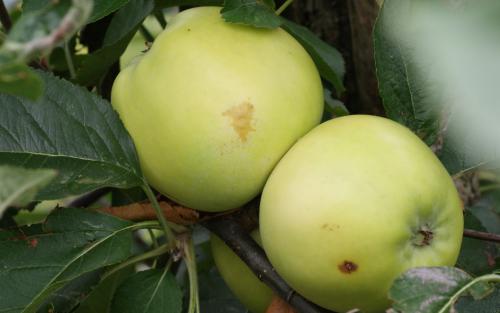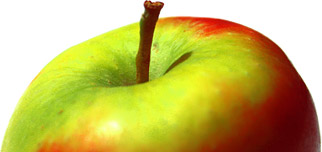
Golden Noble is a well-known English cooking apple, originating in the early 19th century. It was discovered by the gardener of Sir Thomas Harr of Stowe Hall in Norfolk, who obtained a cutting from a tree in a nearby orchard. Sir Thomas presented it to the Horticultural Society of London in 1820. It soon established itself as a popular culinary apple.
Golden Noble remains a popular garden apple in the UK to this day. It has several excellent qualities and deserves consideration if you are looking for a more interesting alternative to Bramley's Seedling. It produces attractive blossom, and the tree generally grows in neat and tidy fashion (unlike Bramley) making it a good choice as a feature tree for the garden. It also bears fruit early in its life. In the kitchen it cooks down to a puree with, for a cooker, a relatively sweet flavour which holds up well in cooking.
Golden Noble therefore has all the attributes of a good cooking apple - at least in English eyes. It has not had much success outside the UK, probably because in Europe and North America there is a preference for apples which keep their shape - what the English regard as a puree the Americans see as a mush.
Golden Noble apple identification images
All images copyright Orange Pippin unless otherwise stated.
USDA identification images for Golden Noble
The identification paintings in the USDA Pomological Watercolor Collection span the years 1886 to 1942.
Citation: U.S. Department of Agriculture Pomological Watercolor Collection. Rare and Special Collections, National Agricultural Library, Beltsville, MD 20705.
Offspring of this variety
Visitor reviews
- 24 Nov 2018 HAMILTON, United KingdomIdeal for our small garden. Cooks quickly to a purée and doesn't need much sugar. A bit prone to scab. I can eat them as a dessert apple, but a bit too sour for the rest of the family. We're 55 degrees north here and it seems to thrive. Bumper year 2018, over 700 apples!
- 14 Apr 2017 CALIFORNIA, United StatesIn Southern California, Golden Noble apples ripen fully in October and are very sweet. The apples grow large and have a yellow skin when ripe. It makes a great eating apple.
- 26 Nov 2011 WI, United StatesThis is a great base apple for cider -- lots of juice, good balance of tartness and sweetness (not so much astringency though), and not too expensive. You get a lot of bang for your resources out of this apple.
- 17 Jan 2011 CAMBS, United KingdomTotally agree with comments. I also find the apples are excellent for eating, just before they fully ripen. Nice thin skins. I make purees and chutney with them. The late blossoming is an advantage in avoiding frost. My tree is in a dry and windy situation but does really well in spite of this. I prune it to keep it in proportion with the size of my garden. V. attractive to butterflies and bees all season. Above table v. useful.
Tree register
United States
- Axel Kratel in Santa Cruz, CALIFORNIA
- Dave Beamer in Santa Barbara, CALIFORNIA
- Jo Elsmore in BLOORS,
- Nathan Parker in Mount Shasta, CA
- Rick Simoniello in Storrs / Mansfield, CT
United Kingdom
- Alison Clare in Newport, SHROPSHIRE
- Alison Quinsey in Beccles, SUFFOLK
- Alison Underwood in Colwyn Bay, NORTH WALES
- Alison Underwood in Colwyn Bay, NORTH WALES
- Bill Potter in Crosby, Maryport, CUMBRIA
- Carole Alderman in Peterborough, CAMBS
- Conrad Maloney in CHELTENHAM, GLOUCESTERSHIRE
- David Kenning in Whitstable, KENT
- Dougas Wilson in Perth,
- Dr Dennis Bancroft in Near Rugby, NORTHAMPTONSHIRE
- Elaine Evans in Mold, FLINTSHIRE
- Graham Charles Schofield in Newmarket, SUFFLOK
- Graham Hinchliffe in Eastbourne, EAST SUSSEX
- Hugh Keep in Stratford-Upon-Avon, WARWICKSHIRE
- John in Hythe, KENT
- John Leitch in Ayr, AYRSHIRE
- Mark Sheard in Leyburn, NORTH YORKS
- Nick Burrows in Helmsley, NORTH YORKSHIRE
- Steve Stoodley in Glastonbury, SOMERSET
- Susan Mcbain in Northwich, CHESHIRE
- Suzanne Mcnally in Banbury, OXON
- Tony Burch in Blandford Forum, DORSET
- Tv15 in Basingstoke,
Spring blossom records for this variety
2014 season
- 12th May 2014 - tree owned by Mark in Leyburn, United Kingdom
2013 season
- April 2013 - tree owned by Dave in Santa Barbara, United States
2012 season
- 25th April 2012 - tree owned by Carole in Peterborough, United Kingdom
2011 season
- 19th April 2011 - tree owned by Hugh in Stratford-Upon-Avon, United Kingdom
2009 season
- May 2009 - tree owned by Carole in Peterborough, United Kingdom
- April 2009 - tree owned by Hugh in Stratford-Upon-Avon, United Kingdom
Record your blossom dates in our Fruit Tree Register - more >>.
Harvest records for this variety
2019 season
- 3rd week September 2019 - tree owned by Tony in Blandford Forum, United Kingdom
2016 season
- October 2016 - tree owned by Elaine in Mold, United Kingdom
2013 season
- October 2013 - tree owned by Dave in Santa Barbara, United States
2011 season
- 4th week September 2011 - tree owned by Hugh in Stratford-Upon-Avon, United Kingdom
- 2nd week September 2011 - tree owned by Carole in Peterborough, United Kingdom
2010 season
- 1st week September 2010 - tree owned by Hugh in Stratford-Upon-Avon, United Kingdom
2009 season
Origins
- Species: Malus domestica - Apple
- Parentage: Unknown
- Originates from: Norfolk, England, United Kingdom
- Introduced: 1820
- UK National Fruit Collection accession: 1974-407
Identification
- Awards: RHS AGM (current)
- Country of origin: United Kingdom
- Period of origin: 1800 - 1849
- Flower colour: Pink - light
- Leaf colour: Green
- Popularity: Rarely grown
- Annual cycle: Deciduous
Using
- Picking season: Late
- Keeping (of fruit): 3 months or more
- Flavour quality: Very good
- Flavour style (apples): Sharper
- Cooking result: Puree
- Discoloration of fruit: No discoloration (Good for drying)
- Vitamin C content: High
- Cropping: Good
- Food uses: Culinary
- Food uses: Juice
- Food uses: Traditional cooker
- Picking period: early October
- Wildlife: RHS Plants for Pollinators
Growing
- Gardening skill: Beginner
- Flowering group: 5
- Pollinating others: Average
- Ploidy: Diploid
- Precocity: Precocious
- Bearing regularity: Regular
- Attractive features: Attractive flowers
- Attractive features: Attractive tree / plant
- Longevity: Long-lived
- Self-fertility: Not self-fertile
Climate
- Frost resistance of blossom: Susceptible
- Climate suitability: Temperate climates
- Climate suitability: Mild damp climates
- Summer average maximum temperatures: Cool ( 20-24C / 68-75F)
- Summer average maximum temperatures: Warm (25-30C / 76-85F)
- Cold hardiness (RHS): H6 (to -20C)
Other qualities
- Disease resistance: Average
- Canker: Some resistance
- Scab (Apple and Pear): Some resistance
- Powdery mildew: Very susceptible
- Fire blight: Very susceptible
Where to buy fresh fruit
The following orchards grow Golden Noble:
United States
Iowa
- Wilson's Orchard, Iowa City
Michigan
- Alber's Orchard & Cider Mill, Manchester
Minnesota
- Two Fruit's Fruits, Hinckley
United Kingdom
England - midlands
- The Vyne, Basingstoke
England - north
- Coulton Mill, York
Canada
British Columbia
- Salt Spring Apple Company, Salt Spring Island
Australia
Victoria
- Heritage Fruits Society, Fairfield
References
- Apples of England (1948)
Author: Taylor - Fruit Expert
Author: Hessayon

